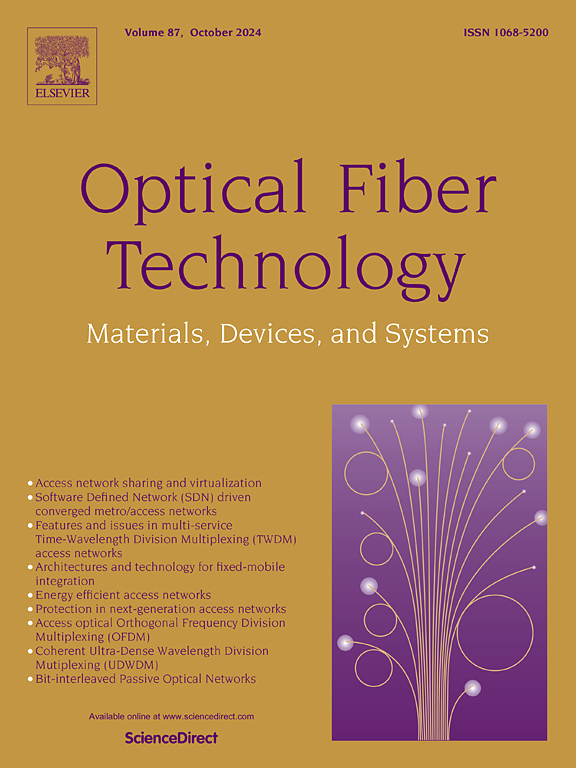A novel fragmentation metric and fragmentation-aware adaptive routing and spectrum allocation algorithm in elastic optical network
IF 2.7
3区 计算机科学
Q2 ENGINEERING, ELECTRICAL & ELECTRONIC
引用次数: 0
Abstract
Next-generation elastic optical networks are being developed to accommodate the increasing demands of heterogeneous traffic for 5G/6G communication. The arrival and departure of this real-time traffic are inherently dynamic. Such dynamic traffic requests, combined with varying bandwidth requirements, lead to spectral fragmentation within the links. Link fragmentation refers to the presence of non-contiguous available spectrum slices within these links. An increase in the number of link fragments diminishes the width of the available frequency slots, which may not meet spectrum constraints, thereby resulting in higher blocking rates within the network. Consequently, it is essential to assess link spectral fragmentation to implement an effective spectrum management strategy. Various metrics for measuring fragmentation in links have been proposed in the literature, including external fragmentation metric (EFM), entropy-based fragmentation metric (EBFM), root mean square fragmentation metric (RMSFM), and golden fragmentation metric (GFM). This paper highlights the limitations of these existing metrics and introduces a novel spectrum slice-based fragmentation metric (SSFM). To evaluate the effectiveness of SSFM, in comparison to EFM, EBFM, RMSFM and GFM, a fragmentation status aware adaptive routing and spectrum allocation (FSA-RSA) algorithm has been developed. Simulations are conducted on German, USNET and Telecom Italia (TI) network topologies. To evaluate the effectiveness of SSFM in relation to other fragmentation metrics, we have employed the following measures: Execution Time (ET), Computational Overhead Ratio (COR), Memory Overhead (MO) and we have evaluated the following performance metrics as a quantitative tool for measuring the effectiveness of the proposed FSA-RSA (SSFM) algorithm against benchmark algorithms: throughput, Request Blocking Probability (RBP), Fractional Spectrum Utilization (FSU), and Link Fragmentation Metric (LFM). Among these, throughput and execution time are regarded as the primary performance metrics. The findings suggest that the FSA-RSA (SSFM) algorithm enhances network performance, yielding an average minimum throughput increase of 3.5%, 0.12% and 108% when compared to the FSA-RSA (EBFM), FSA-RSA (EFM) and FSA-RSA (GFM) algorithms, respectively. However, it exhibits a throughput that is 0.0049% lower than that of the FSA-RSA (RMSFM) algorithm, a shortfall that can be offset by the reduced execution time and memory overhead associated with SSFM in comparison to RMSFM.
弹性光网络中一种新的碎片度量和碎片感知自适应路由和频谱分配算法
下一代弹性光网络正在开发中,以适应5G/6G通信日益增长的异构流量需求。这种实时交通的到达和离开本质上是动态的。这种动态的业务请求,加上不同的带宽需求,导致链路内的频谱碎片化。链路碎片是指在这些链路中存在不连续的可用频谱片。链路片段数量的增加减少了可用频率槽的宽度,这可能不满足频谱限制,从而导致网络内更高的阻塞率。因此,有必要评估链路频谱碎片,以实施有效的频谱管理策略。文献中提出了各种度量链路碎片的度量,包括外部碎片度量(EFM)、基于熵的碎片度量(EBFM)、均方根碎片度量(RMSFM)和黄金碎片度量(GFM)。本文强调了这些现有度量的局限性,并介绍了一种新的基于频谱切片的碎片度量(SSFM)。为了评估SSFM算法的有效性,与EFM、EBFM、RMSFM和GFM算法进行了比较,提出了一种分片状态感知的自适应路由和频谱分配(FSA-RSA)算法。在德国、USNET和意大利电信(TI)的网络拓扑上进行了仿真。为了评估SSFM相对于其他碎片度量的有效性,我们采用了以下度量:执行时间(ET)、计算开销比(COR)、内存开销(MO),并且我们评估了以下性能度量作为衡量拟议的FSA-RSA (SSFM)算法与基准算法的有效性的定量工具:吞吐量、请求阻塞概率(RBP)、分数频谱利用率(FSU)和链路碎片度量(LFM)。其中,吞吐量和执行时间被认为是主要的性能指标。研究结果表明,与FSA-RSA (EBFM)、FSA-RSA (EFM)和FSA-RSA (GFM)算法相比,FSA-RSA (SSFM)算法提高了网络性能,平均最小吞吐量分别提高了3.5%、0.12%和108%。然而,它的吞吐量比FSA-RSA (RMSFM)算法低0.0049%,与RMSFM相比,SSFM的执行时间和内存开销减少了,这可以抵消这一不足。
本文章由计算机程序翻译,如有差异,请以英文原文为准。
求助全文
约1分钟内获得全文
求助全文
来源期刊

Optical Fiber Technology
工程技术-电信学
CiteScore
4.80
自引率
11.10%
发文量
327
审稿时长
63 days
期刊介绍:
Innovations in optical fiber technology are revolutionizing world communications. Newly developed fiber amplifiers allow for direct transmission of high-speed signals over transcontinental distances without the need for electronic regeneration. Optical fibers find new applications in data processing. The impact of fiber materials, devices, and systems on communications in the coming decades will create an abundance of primary literature and the need for up-to-date reviews.
Optical Fiber Technology: Materials, Devices, and Systems is a new cutting-edge journal designed to fill a need in this rapidly evolving field for speedy publication of regular length papers. Both theoretical and experimental papers on fiber materials, devices, and system performance evaluation and measurements are eligible, with emphasis on practical applications.
 求助内容:
求助内容: 应助结果提醒方式:
应助结果提醒方式:


